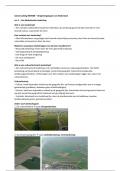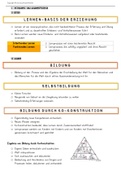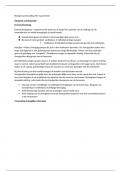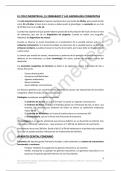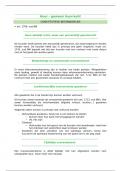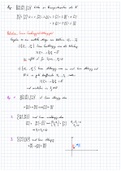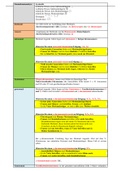Week 2 - Social Construction
● Criminology
○ = study of the nature, extent, causes and control of criminal behavior
● Criminologists tackle 5 main questions:
○ Definition - which types of harmful behaviour are considered criminal and why
○ Scope - the size of the specific crime problems and how to measure them, but
also ‘business processes’ and how crimes are committed (which skills,
knowledge and tools are required)
○ Explanation - why and where crimes occur and how criminal behavior may be
explained from a theoretical perspective
○ Consequence - consequences of the crime for perpetrators, victims, ecosystems,
etc
○ Evaluation - how can crime be tackled or prevented and what is the effect of
punishment
● These 5 questions are addressed at different levels:
○ Individual level - pov of villains and victims
○ Criminal process - criminologists look at this
○ Structural perspective - here crimes are studied by looking at societal drivers
● Only a small nr of offenses are considered criminal/deviant in every culture:
○ indiscriminate lying, theft, violence and causing suffering, incest!
● Philosophical approach: aims to objectively define liberty limiting principles
● John Stuart Mill: harm principle
○ That the only purpose for which power can be rightfully exercised over any
member of a civilized community, against his will, is to prevent harm to others.
● Paternalism: liberties may be limited to prevent individuals from causing harm to
themselves.
● Moralism: liberties may be limited when societies reject behaviour, regardless whether
the behaviour causes harm.
● Offense principle: liberties may be limited if behaviour visibly offends other people,
regardless of harm being caused.
● Sensitising concepts: Interaction (e.g. language, images) structures how people
experience, interpret and attribute meaning to everyday reality.
● Social construction
○ Human social relations and behaviour are regulated through social norms. A
social norm is ‘any standard rule that states what human beings should or should
not think, say or do under given circumstances’. These norms are continuously
defined and redefined by the members of a social group.
○ Larger communities cannot constantly (re)define norms in direct personal
interactions. Instead, norms are ‘informally codified’ in what we define as culture.
Laws are formalised codifications of societal norms
○ Cultural norms (and laws) are necessarily simplified representations of the
complexities of everyday life. These simplifications are called ‘frames.’ In specific
, situations, there may be a lot of reasons why general social norms would
perhaps not apply
● Defining setting
○ Communities define their own norms. Who: individuals, interest groups,
institutions, political parties, religious actors, the media – increasingly social
media – science, et cetera. Where: Local, national, international. Definitions are
not static, but change over time.
○ The power to define is spread unevenly within societies. Powerful economic
actors may exert disproportionate influence. Weaker groups in society may not
be heard.
○ Increased complexity of definition setting: Increased complexity of societies
Digitalisation and ‘bubbles’. Global interests versus national sovereignty
● White-collar crimes → rich people get away easier with crimes
○ Geis’s solution: 4 types of white-collar crimes
1. Crimes committed by individual actors against random victims (online
fraud)
2. Crimes committed by an employee against his employer / occupational
crime (embezzlement)
3. Crimes committed by corporations against its employees (exposing them
to dangerous working conditions)
4. Crimes committed by corporations against customers and random victims
/ corporate crime (selling cars that are inherently unsafe) “offenses
committed by legal persons in the context of their regular business
activities”
● Civil law countries → penalizes regulatory offenses as economic offenses which are
included in the penal code
● States can also be involved in criminal activity
○ Chambliss: state organized crimes = acts defined by law as criminal and
committed by state officials in the pursuit of their job as representatives of the
state
○ Ward: state harm = an act or omission of an action by actors within the state that
results in violations of domestic and international law, human rights, or in
systematic or institutionalized harm of its own or another state’s population
● Green criminology - focusing on not only humans, but also non-human
animals/ecosystems/biosphere
Week 3 - Punishment
● Backward-looking justifications → retributive, looking at the crime and the
seriousness of the overriding considerations for imposing sentences
● Forward-looking justifications → utilitarian, looking at the consequences following the
crime and the rehabilitation of the criminal or deterring others from committing crime
● Jeremy Bentham → punishment should be quick & certain, the costs in terms of the
punishment should be equal to the gains of the crime, his pov relates most to deterrence
, ○ He said that punishment shouldn’t be used where it is either 1. Groundless, 2.
Inefficacious, 3. Unprofitable, 4. Needless
○ If punishment wasn’t likely to be promoting happiness, then choose the
punishment that will cause the least unhappiness
○ Deterrence theory - people are rational beings who adjust their conduct in terms
of the calculations they make as to the consequences of their behaviour
● Victim impact statement (VIS) - rectifying the victim’s traditional lack of voice in a trial,
this informs the judge about any physical or psychological harm/loss/damage suffered by
the victim as a result of the crime
● Opponents against VIS ^ criticize it for challenging the general conception of crime as a
violation against the ‘state’ and not an ‘individual’
● Just Deserts
● Integrated model of punishment:
○ Specific prevention
■ Rehabilitation
■ Special deterrence (prevention of re-offending)
■ Incapacitation
○ General prevention
■ General deterrence
■ Preventing that people take the law into their own hands
■ reinforcing/reconfirming societal norms
○ Compensating the victim
■ Retribution
■ Compensation for damage
■ Resolving of conflicts
● Emile Durkheim - societies know their basic moral values, so whenever someone
violates those, it will provoke collective moral outrage and a passionate desire for
vengeance
● Peter Kropotkin - ‘prisons are the universities of crime’, criminals are able to ‘network’
inside the prison and learn better techniques for future offences
● Michel Foucault - discipline is important
● Criminological questions
○ Does punishment ‘work’ as an effective response to crime?
■ Which proportion of perpetrators is punished?
■ Does it matter how many people we send to jail?
■ Does it matter which sentence we impose?
○ Is the criminal justice system fair or biased?
■ Bias between the rich and poor
■ Racial bias
● General observations
○ In countries where levels of inequality are higher, governments tend to rely more
on (harsh) punishment.
○ On average there’s little-to-no relationship between crime levels and
incarceration levels.
, ○ Legal sanctions either reduce, increase, or have no effect on the commission of
future crimes, depending on a host of variables including the type of offender, the
nature of the offense, and the social setting.
○ Sanctions are more effective when offenders view these as legitimate, when they
have strong bonds to the community and the sanctioning agent, and when
offenders accept their shame and are not isolated from society.
● Wealth bias
○ Prior employment levels of inmates are exceptionally low.
○ A large nr of men and women in the Us prison system come from just a handful
of deeply impoverished neighbourhoods.
○ The rich are usually involved in corporate crime and operate under the protective
cloak of their corporations.
○ Even if they do not commit common crimes, penalties are usually low.
○ Jails and prisons are filled with poor people; rich citizens are rarely incarcerated
○ ‘The poor do time, the rich pay fines’
● Racial bias
○ In the US around 2005, 1 in 3 black males could expect to go to prison in his
lifetime, compared to 1 in 6 hispanic males and 1 in 17 white males
○ The rates of illegal drug use for whites and blacks are similar, with almost 9% for
white and almost 10% for blacks.
○ Rich black kids have been more likely to go to prison than poor white kids.
● From a criminological perspective → alternative approaches work better to keep crime
levels down (prevention & restorative justice/ reconciliation)
● Enforcement toolboxes:
●
● Corporations may violate regulations because they are not aware of all things they need
to comply with. First step - provide them with information and help them to adjust.
Second step - official warning. Third step - imposing financial penalties. Fourth step -
shut down operations. Fifth step - stop all activities and revoke licenses
● Criminology
○ = study of the nature, extent, causes and control of criminal behavior
● Criminologists tackle 5 main questions:
○ Definition - which types of harmful behaviour are considered criminal and why
○ Scope - the size of the specific crime problems and how to measure them, but
also ‘business processes’ and how crimes are committed (which skills,
knowledge and tools are required)
○ Explanation - why and where crimes occur and how criminal behavior may be
explained from a theoretical perspective
○ Consequence - consequences of the crime for perpetrators, victims, ecosystems,
etc
○ Evaluation - how can crime be tackled or prevented and what is the effect of
punishment
● These 5 questions are addressed at different levels:
○ Individual level - pov of villains and victims
○ Criminal process - criminologists look at this
○ Structural perspective - here crimes are studied by looking at societal drivers
● Only a small nr of offenses are considered criminal/deviant in every culture:
○ indiscriminate lying, theft, violence and causing suffering, incest!
● Philosophical approach: aims to objectively define liberty limiting principles
● John Stuart Mill: harm principle
○ That the only purpose for which power can be rightfully exercised over any
member of a civilized community, against his will, is to prevent harm to others.
● Paternalism: liberties may be limited to prevent individuals from causing harm to
themselves.
● Moralism: liberties may be limited when societies reject behaviour, regardless whether
the behaviour causes harm.
● Offense principle: liberties may be limited if behaviour visibly offends other people,
regardless of harm being caused.
● Sensitising concepts: Interaction (e.g. language, images) structures how people
experience, interpret and attribute meaning to everyday reality.
● Social construction
○ Human social relations and behaviour are regulated through social norms. A
social norm is ‘any standard rule that states what human beings should or should
not think, say or do under given circumstances’. These norms are continuously
defined and redefined by the members of a social group.
○ Larger communities cannot constantly (re)define norms in direct personal
interactions. Instead, norms are ‘informally codified’ in what we define as culture.
Laws are formalised codifications of societal norms
○ Cultural norms (and laws) are necessarily simplified representations of the
complexities of everyday life. These simplifications are called ‘frames.’ In specific
, situations, there may be a lot of reasons why general social norms would
perhaps not apply
● Defining setting
○ Communities define their own norms. Who: individuals, interest groups,
institutions, political parties, religious actors, the media – increasingly social
media – science, et cetera. Where: Local, national, international. Definitions are
not static, but change over time.
○ The power to define is spread unevenly within societies. Powerful economic
actors may exert disproportionate influence. Weaker groups in society may not
be heard.
○ Increased complexity of definition setting: Increased complexity of societies
Digitalisation and ‘bubbles’. Global interests versus national sovereignty
● White-collar crimes → rich people get away easier with crimes
○ Geis’s solution: 4 types of white-collar crimes
1. Crimes committed by individual actors against random victims (online
fraud)
2. Crimes committed by an employee against his employer / occupational
crime (embezzlement)
3. Crimes committed by corporations against its employees (exposing them
to dangerous working conditions)
4. Crimes committed by corporations against customers and random victims
/ corporate crime (selling cars that are inherently unsafe) “offenses
committed by legal persons in the context of their regular business
activities”
● Civil law countries → penalizes regulatory offenses as economic offenses which are
included in the penal code
● States can also be involved in criminal activity
○ Chambliss: state organized crimes = acts defined by law as criminal and
committed by state officials in the pursuit of their job as representatives of the
state
○ Ward: state harm = an act or omission of an action by actors within the state that
results in violations of domestic and international law, human rights, or in
systematic or institutionalized harm of its own or another state’s population
● Green criminology - focusing on not only humans, but also non-human
animals/ecosystems/biosphere
Week 3 - Punishment
● Backward-looking justifications → retributive, looking at the crime and the
seriousness of the overriding considerations for imposing sentences
● Forward-looking justifications → utilitarian, looking at the consequences following the
crime and the rehabilitation of the criminal or deterring others from committing crime
● Jeremy Bentham → punishment should be quick & certain, the costs in terms of the
punishment should be equal to the gains of the crime, his pov relates most to deterrence
, ○ He said that punishment shouldn’t be used where it is either 1. Groundless, 2.
Inefficacious, 3. Unprofitable, 4. Needless
○ If punishment wasn’t likely to be promoting happiness, then choose the
punishment that will cause the least unhappiness
○ Deterrence theory - people are rational beings who adjust their conduct in terms
of the calculations they make as to the consequences of their behaviour
● Victim impact statement (VIS) - rectifying the victim’s traditional lack of voice in a trial,
this informs the judge about any physical or psychological harm/loss/damage suffered by
the victim as a result of the crime
● Opponents against VIS ^ criticize it for challenging the general conception of crime as a
violation against the ‘state’ and not an ‘individual’
● Just Deserts
● Integrated model of punishment:
○ Specific prevention
■ Rehabilitation
■ Special deterrence (prevention of re-offending)
■ Incapacitation
○ General prevention
■ General deterrence
■ Preventing that people take the law into their own hands
■ reinforcing/reconfirming societal norms
○ Compensating the victim
■ Retribution
■ Compensation for damage
■ Resolving of conflicts
● Emile Durkheim - societies know their basic moral values, so whenever someone
violates those, it will provoke collective moral outrage and a passionate desire for
vengeance
● Peter Kropotkin - ‘prisons are the universities of crime’, criminals are able to ‘network’
inside the prison and learn better techniques for future offences
● Michel Foucault - discipline is important
● Criminological questions
○ Does punishment ‘work’ as an effective response to crime?
■ Which proportion of perpetrators is punished?
■ Does it matter how many people we send to jail?
■ Does it matter which sentence we impose?
○ Is the criminal justice system fair or biased?
■ Bias between the rich and poor
■ Racial bias
● General observations
○ In countries where levels of inequality are higher, governments tend to rely more
on (harsh) punishment.
○ On average there’s little-to-no relationship between crime levels and
incarceration levels.
, ○ Legal sanctions either reduce, increase, or have no effect on the commission of
future crimes, depending on a host of variables including the type of offender, the
nature of the offense, and the social setting.
○ Sanctions are more effective when offenders view these as legitimate, when they
have strong bonds to the community and the sanctioning agent, and when
offenders accept their shame and are not isolated from society.
● Wealth bias
○ Prior employment levels of inmates are exceptionally low.
○ A large nr of men and women in the Us prison system come from just a handful
of deeply impoverished neighbourhoods.
○ The rich are usually involved in corporate crime and operate under the protective
cloak of their corporations.
○ Even if they do not commit common crimes, penalties are usually low.
○ Jails and prisons are filled with poor people; rich citizens are rarely incarcerated
○ ‘The poor do time, the rich pay fines’
● Racial bias
○ In the US around 2005, 1 in 3 black males could expect to go to prison in his
lifetime, compared to 1 in 6 hispanic males and 1 in 17 white males
○ The rates of illegal drug use for whites and blacks are similar, with almost 9% for
white and almost 10% for blacks.
○ Rich black kids have been more likely to go to prison than poor white kids.
● From a criminological perspective → alternative approaches work better to keep crime
levels down (prevention & restorative justice/ reconciliation)
● Enforcement toolboxes:
●
● Corporations may violate regulations because they are not aware of all things they need
to comply with. First step - provide them with information and help them to adjust.
Second step - official warning. Third step - imposing financial penalties. Fourth step -
shut down operations. Fifth step - stop all activities and revoke licenses


